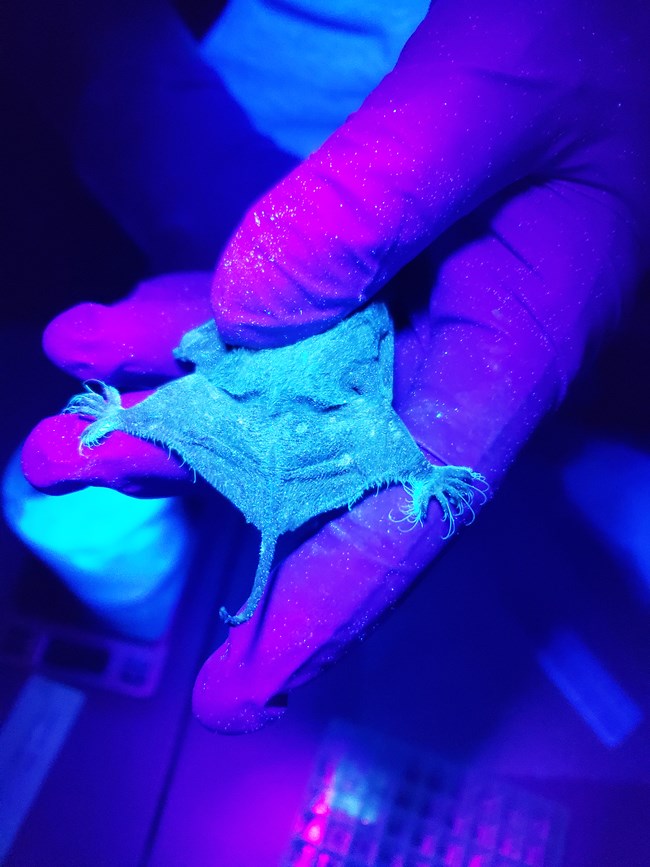Last updated: December 17, 2020
Article
UV-C Light Could Control White-Nose Syndrome, but First Let’s Ask the Cave Biota
Spring/Summer 2019 - If you suffer from germophobia or chiroptophobia, the fear of germs or bats, I can relate. However, if you enjoy mosquito-free campfires, food, and have a general dislike for insect borne diseases like West Nile virus, please read on!

NPS / Katrina Smith
A single bat can eat 7,000 mosquitoes every night. This ferocious appetite for insects reduces the spread of insect borne diseases, saves your backyard barbeque from becoming a forehead slapping party, and saves farmers $3.7 billion in pest control each year. Sadly, many species of the world’s only flying mammals are experiencing 90–100% decline in some areas due to Pseudogymnoascus destructans (Pd), the fungus that causes white-nose syndrome. White-nose syndrome causes bats to wake up more frequently during hibernation, wasting precious fat reserves, which often leads to starvation. It was first detected in New York in 2006 and has been steadily spreading westward across the United States. In 2016 the fungus jumped several states to King County, Washington. This range expansion came as an unpleasant surprise—like opening that container from the back of the fridge and vaguely remembering spaghetti night. With the spread of the fungus to the West Coast, Klamath Inventory and Monitoring Network scientists and park staff are checking the health of local bat populations and collaborating with researchers to find a treatment before the fungus potentially turns up at the network’s two cave parks: Oregon Caves National Monument and Preserve and Lava Beds National Monument.
A promising control is on the horizon. Pseudogymnoascus destructans has been evolving in dark caves for millions of years and is unable to repair cells after exposure to Ultraviolet C (UV-C) light. Low dosages of UV-C light have an antimicrobial effect without harming animal tissues. This method is showing great promise for bats in laboratory settings. If applying UV-C light to cave walls turns out to be the most effective method, rather than treating individual bats, the impact of UV-C light on other cave organisms needs to be investigated. This is because many cave species are still a mystery, and the National Park Service is committed to protecting all species, including those whose functions are not fully understood.
Caves may appear sterile to the novice spelunker. However, caves are chock full of microorganisms, such as Proteobacteria (a phylum that includes pathogens such as salmonella) and Bacteroidetes (a phylum of bacteria that includes many species that inhabit the intestinal tracts, feces, and oral cavities of mammals, including humans). I liken it to the kitchen sink sponge that needs replacing. You can’t see the bacteria, but they’re there! Cave microorganisms make up the base of the cave food web. According to Pat Seiser (Physical Scientist at Lava Beds NM), larger animals like lizards, coyotes, and woodrats wander through the cave. Droppings from these animals bring nutrients into the cave and provide food for bacteria and fungi. In return, fungus eating insects feed on cave fungi and bacteria, linking together the subterranean and above ground world. A fun fact for all you germophobes, many cave microorganisms are used in the medical field. For example, Actinobacteria produce about two-thirds of all naturally derived antibiotics. Given their importance in the cave ecosystem and their potential value to humans, the effects of UV-C on native cave microorganisms need to be understood before any widespread treatment for white-nose syndrome.

Emily Lind
Beyond their work monitoring long-term trends in natural resource “vital signs” in parks, Klamath Network scientists are sometimes called upon to apply their expertise to emerging park issues. Park visitors almost never see network crews, but behind the scenes they work hard to help parks protect their resources. With Pd knocking at the door, John Roth, Natural Resource Specialist at Oregon Caves, reached out to several scientists for help. He asked, “How can we treat our caves to reduce Pd, and what might be the side effects to other cave inhabitants?” Alice Chung- MacCoubrey (Klamath Network) was part of the team that quickly came together to help answer this question, along with Katrina Smith (Lava Beds), Rick Toomey (Mammoth Cave in Kentucky), and cave researcher Diana Northrup (University of New Mexico). Together they are studying the effects of UV-C light on cave microorganisms, and how effective it is at reducing Pd at Mammoth Cave.

Emily Lind
Phase one of this research project is looking at the effects UV-C has on cave microorganisms in a laboratory setting. In 2018 park staff swabbed caves to collect microorganisms at two parks free of Pd: Oregon Caves and Lava Beds, and one park with Pd: Mammoth Cave in Kentucky. Collaborator Diana Northup will dilute the samples until each bacteria species is isolated from the others. These isolates will be exposed to the same levels of UV-C light that will be used to reduce Pd in caves. If the treatments have any negative impacts on the bacteria, researchers will examine how long it takes for native cave bacteria to recover following UV-C treatment. In fall 2019, phase two will look at the effects of UV-C on microorganisms in their natural cave settings. They will assess effects immediately following UV-C treatment, and one year after treatment. This will tell researchers how quickly cave microorganisms recover after being exposed to UV-C light. According to Chung-MacCoubrey, “project results will help cave managers understand the costs and benefits of UV-C treatments, allowing them to make informed decisions about the use of UV-C to control the fungus and disease.”
Results of this research won’t be known for a few years, but the clock is ticking. I don’t know about you, but I’m going to savor every bug-free barbeque until an effective control for Pd, that is safe for all organisms, is found.
Article by Emily Lind, Klamath Inventory and Monitoring Network science communication intern, linde1@sou.edu
Adapted from The Klamath Kaleidoscope newsletter, Spring-Summer 2019 issue, by Jessica Weinberg
